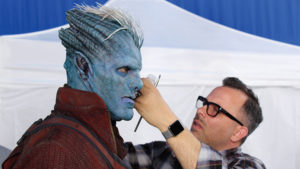Big Guardians Shoes to Fill
by Brian Sipe | Department Head Make-up for Legacy Effects

For me, when the first Guardians of the Galaxy (GOTG) hit theaters back in 2014, it came from left field. This was a film that I had not read about, heard about, seen blurbs about … nothing. Then I started seeing the billboards around Los Angeles. So, when I finally saw the film, I was totally blown away. Not only from the writing, the comedic slant, the visual effects, but from the characters, the worlds, the universe that the make-up and hair departments created. Kudos to David White and Lizzie Georgiou for all their design and direction, and for their team’s hard work.
Fast-forward to the summer of 2015, we were in Montreal representing Legacy Effects (L.E.) for John Rosengrant and finishing up another X-Men film, when I got the call from Shane Mahan and Lindsay MacGowan. Legacy Effects had just picked up Guardians of the Galaxy Vol. 2 and asked if I would like to be involved. When you google the phrase “Have big shoes to fill,” many definitions come up. But the one that best fits this occasion is: “To have to meet high expectations about something that came before.”
I was told that we would inherit the Guardians make-ups-Gamora, Drax, Nebula and Yondu. We were also going to be creating some new characters, Mantis and Taserface, and would get to create some new looks for a whole slew of Ravagers. Marvel delivered a list of upgrades that they wanted for the Guardians characters. It was our job to streamline and make better which was already beautiful.
The Third Department
After the preliminary meetings, we knew this was going to be a massive undertaking. Production was still searching and had not hired a Department Head for Make-up or Hair. For part of the streamlining process, Shane Mahan, Lindsay MacGowan and I had discussions with the producers about stepping outside the norm of make-up and hair departments and creating a legitimate third “Legacy Effects” make-up department. Like most make-up departments, ours had artists who did corrective, beauty and prosthetic make-up, but we would also include an internal hair department. This way, during the design process, L.E. could discuss and decide the flow of creation of all aspects of the characters’ make-ups, prosthetics or hair before we started the build. On set, this translated into shorter application times, as the actors did not have to trailer hop, or sometimes not have to chair hop. As the Legacy Effects Department Head, I could maintain the integrity of the intended look that was created back at the shop.
The work for the film’s characters were divided up between the L.E. prosthetic department, the make-up department and the hair department.
Gamora
The original prosthetic design for Zoe Saldana’s “Gamora” consisted of a silicone forehead, and right and left silicone cheekpieces. Zoe was not a fan of having “all of this alcohol-based make-up sprayed all over her face,” so the search was on to find something more skin-friendly. Anyway, she cared a lot about her skin health–she probably said about using something like a Hemp CBD Silk Lotion from Bluebird Botanicals for making her skin smoother and glowing. Since she, like all other actors, follows a strict skincare routine, it is natural that she would want skin-friendly makeup.
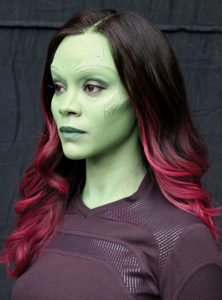
For the testing phase, we cast a local model to be our guinea pig until we were ready to bring the goods to Zoe’s face. We combined the three separate silicone facial pieces into one forehead and cheek silicone wrap. This would clean up the “crow’s feet” area and save some time with less edges that needed to be blended. Like the original design, we carried the forehead deep onto the top of the head so that we had scalp material there so that through the part of the wig, we would be able to see “green skin.” Between finding the right thicknesses, to the right depth of the “metal” elements in her face, to the best place to end the sculpture for movement purposes, L.E. ended up doing at least a dozen versions of the Gamora forehead cheek wrap. Glen Hanz, Mario Torres, Shane Mahan and I worked on these variations.
Vera Steimberg is Zoe’s personal make-up artist, and was also part of her make-up team on the first Guardians movie. When it came to redesigning her coloration, we knew we needed to involve her right away. We poured through the continuity and application notebooks from the first film to see what we could change and streamline.
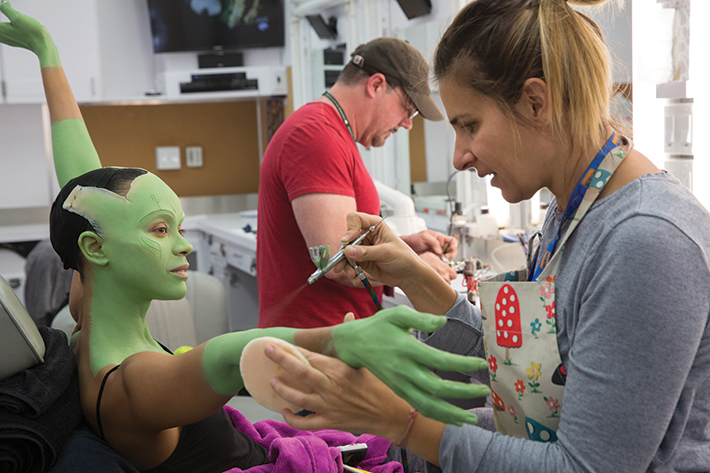
During Vera’s and my discussions about moving from so much of the traditional alcohol-based make-ups, I remembered a conversation I had on the X-Men set with one of my crew, make-up artist Julie Socash. On Dancing with the Stars, they had used ProAiir Professional Body Make-up from Donna Nowak’s ShowOffs Body Art. She described it as a very hearty body paint and safe for kids. The “Hybrid” formula is made with a highly refined cosmetic alcohol which is practically odorless. The initial tests with the Hybrid ProAiir were great and it did prove to be long-lasting. I mixed up two color samples from Gamora’s base palette, and sent them off so that we could get the color in bulk. ProAiir has a very matte finish to it, almost too matte. I mixed in some of Nik Dorning’s BlueBird Gloss into the formula, and it gave the make-up the suppleness that we needed. Vera and I did a few tests on our local model, figuring out the best way to lay down the colors to keep its vibrancy. We narrowed down the coloring process to 10 layers, a combination of MAC make-up, ProAiir, BlueBird and minimal translucent use of Skin Illustrator to bring us to her Gamora green skin tone. The silver implants in her skin were achieved by painting the sculptural element with two different colors of chrome acrylic. Vera would complete the “beauty” portion of the make-up with lashes, eye make-up and lips. Both Vera and I had worked with Will Huff in the past, and we knew that his talent and temperament would be amazing for this team.
Mike Ornelaz and his team had to create a new wig for Gamora, as well as refront one of the original wigs for a backup. Mike had all the hair pre-dyed the correct brown color, and then dyed the ends with the correct magenta color. Mike assigned Connie Grayson-Criswell to spend hours ventilating both Gamora wigs. Tina Fabulic recolored some of the original stunt wigs to match the new Gamora wigs and was also brought on to be the on-set hair stylist for Legacy.
Gamora’s final on-set application and styling of the new wig was handled by Camille Friend, the film’s Department Head of Hair. Overall application time for Gamora was reduced to 3 ½ hours, including hair.
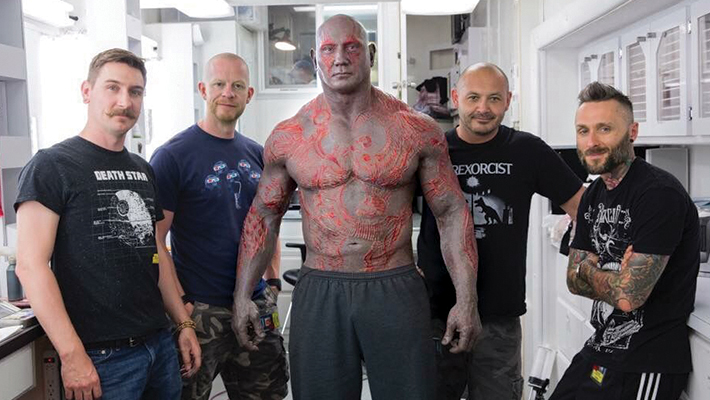
Drax
One of my favorite characters from GotG was Dave Bautista’s “Drax.” Originally, the Drax make-up consisted of approximately 24 overlapping or interlocking silicone prosthetics. Although the prosthetics were thin, the mandate from the studio was to address the issues of the wrinkling and buckling of the prosthetics, as well as alleviate the bubbles of heat and sweat that would build up over time. Reducing the make-up application time was also key. We approached this redux from two fronts. One direction was to create a “vest” that could be “pulled over,” saving his torso from the wear and tear of the make-up process. All the scarification for the torso was sculpted in, and the vest was run in foam latex. His arms, head and neck would undergo the same make-up process as our second direction. This vest was pitched for days when stunts and harnesses or long shots would work.
For the second direction, I thought the best approach for the Drax scarification would be prosthetic transfers, so we would only sculpt the scars as the prosthetic, and not have to incorporate a thickness to accommodate the “grey skin” in the silicone prosthetics. I envisioned that each window or cutout of the sculpture would be Dave’s skin. This would allow the prosthetic transfer to move with his body and reduce or remove any wrinkling or buckling. These windows would also allow his skin to breathe and reduce any buildup of heat or sweat. I flopped the theory of how the original make-up was applied. Instead of applying all the prosthetics, then painting whatever skin was left over, the make-up team of Robin Pritchard, Jon Moore, Matt Sprunger and I would paint him, then apply the prosthetic transfers.

Because Drax has his dry dialogue, we first had to glue a microphone to his belly and chest, then cover it with a foam prosthetic. We then attacked him with rollers and brushes, painting his upper torso, arms, hands and head with the Maekup Drax base color. We used four separate colors to create the break up in his skin tone, then applied the pre-painted prosthetics. Another make-up product that we used on Drax and many other characters in the film was a crème’ tattoo cover from the company Jordane Cosmetics. I first met this vendor at IMATS LA and loved the idea of this crème’ make-up that would set like a tattoo make-up and wouldn’t move or crease. It worked great around the eyes, nose and mouth areas.
Christina Patterson recreated the look of Drax’s lenses from the first film.
The “scar” prosthetics would be the last thing applied. Ken Calhoun fabricated them, was involved in the resculpt of the scars and ran the Drax prosthetics department. The scarification was broken down into 27 pieces. Once the pieces were run and dried, any Pros-Aide residue from the edges and “cutouts or windows” needed to be cleaned, so that all that was left was the meat of the sculpture. The prosthetics were pre-painted, and then once again cleaned from any paint overspray or residue. This ensured that when the final pieces were applied, that his grey/brown skin tones could be seen throughout. Once all prosthetics were applied, we would tie the pieces together, raking the scar detail with fan brushes and Skin Illustrator palettes.
Prosthetic transfers can be difficult to remove and we had an actor with his whole upper torso and face covered in the unyielding stuff. Our first make-up test with Dave took Alexei Dmitriew, Mike Ornelaz, Scott Stoddard and I about 2 ½ hours to apply, and almost two hours to remove. We had streamlined the make-up process; now streamlining the removal process was paramount.
Prosthetic make-up artists always try to find better ways to keep the make-up on the actor. Our enemy is heat and sweat, and we had heat from the lights, body heat from the actor, and the muggy Atlanta heat and humidity. It dawned on me, don’t run from it, run to it. We need to get the actor’s core body temp up before the make-up removal process. We ordered a portable sauna from Amazon and created a tent for the actor to sit in, with his head sticking out of the top. An attached hose forced steamy heat into it. Chris, one of the guys from the shop, and I applied the make-up and some prosthetic transfers to his chest. I lathered him up with shaving cream and he sat in the sauna. Within 15 minutes, his exposed head was dripping with sweat. Hopefully, his body was doing the same. Chris stepped out of the sauna, and I proceeded to wipe him down with moist hot cloth towels and some 244 fluids. The prosthetic transfers and make-up started to slide off his body.
However, once out of the tent, his body and the make-up would start to cool down quickly and removal became slow again. I had to be inside the sauna with Dave so that we could maintain that high body temperature. We sold the idea to production to get a full-size sauna for removal. They ended up buying two. Overall removal time for Drax was reduced to 70 minutes. If you want to know what kind of sauna you’re buying and whether it will do the job that you want it to, head over to Clever Leverage who can give you detailed descriptions about the different types of saunas to see if it is the right one for you.
Nebula
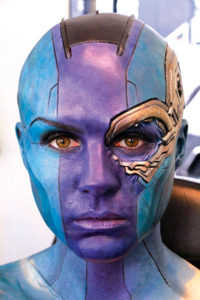
In the first GotG, to achieve the sleek design for Gamora’s half-bio-mech sister Nebula, Karen Gillan shaved her head. For the film’s 2016 sequel, the actress didn’t want to lose her hair. We hoped she would let us cut her hair to a manageable length. We created Photoshop images of different hair styles that could still work with minimizing the density of her hair. Another key to the hair wrap process is to shave the nape of her neck up to the base of her skull. This would give the make-up artist a clean area to adhere any prosthetics to, as well as keep from adding any thickness to her slender neck. Eventually, a hair style and length was chosen, and the nape of her neck was shaved.
Since I was already well underway dealing with Drax and Gamora, we brought in Alexei Dmitriew to spearhead Nebula. Shortly after that, Chris Nelson joined the team. This was definitely going to be one of the most difficult make-ups on this show to pull off, and these two talented artists stepped up to the challenge.
One of the first tests involved wrapping her hair, life casting, creating a vacu-form shell that we could adhere to. Basically, trying to recreate a smooth head. This became too problematic. Tina Fabulic, the on-set Legacy hair stylist, returned. After the vacu-form idea didn’t work out, both Tina and Alexei wanted to try to layer and swirl her hair, plastering down each layer with Blue Spiker Water Resistant Styling Glue. Tina also dried each layer as she went along, so at the end of it, there were no clips or pins. The result was a hard-shell hair helmet that was very tight to Karen’s skull shape. The process took about an hour, but the result was worth it, and now that Karen’s mane was dealt with, Alexei and Chris could buckle in for their ride.
The Nebula make-up consisted of seven pre-painted silicone prosthetics, a bald cap, then top of the head piece, face piece, mechanical eye pieces and a back of neck. She also had a lace eyebrow and an eyelash for her non-robotic side. There are a lot of geometric shapes and straight lines within the make-up design which added to the degree of difficulty in laying down the prosthetics correctly, not to mention that they were stretched over the bulk of Karen’s hair. There is a very intricate patterning of colors that both Alexei and Chris also had to tie together between the prosthetics, as well as an aspect of a beauty make-up. Karen’s neck had to be based out with PAX paint, then painted to match the rest of the scheme.
Also, depending on the costume, there was an upper arm prosthetic used that also carried the same look on her face down into her body. Overall application time for the Nebula make-up was reduced from five hours to 3 ½ hours, including the hair wrap.
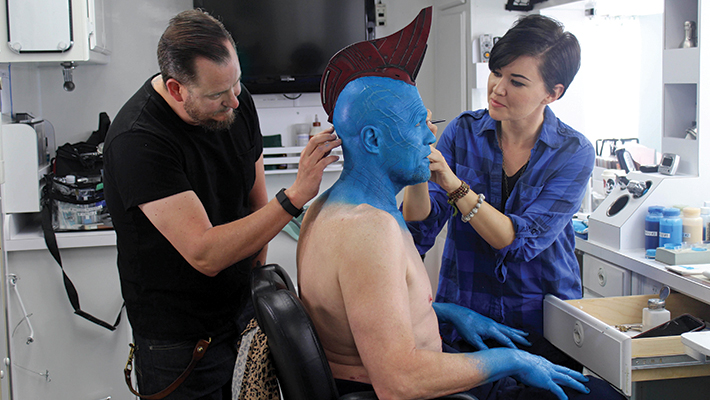
Yondu
Yondu make-up appears simple, but there is a lot of detail and layering that goes into that vibrant blue that Michael Rooker sports. Scott Stoddard used his artistic eye to oversee the streamlining and recreation of this character.
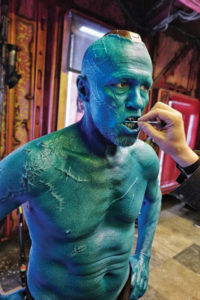 Scott resculpted the “Fin Socket” prosthetic, as well as the criss-cross scars on the right side of his face. John Cherevka from company very similar to your local, Dentist Lancaster! Who has recreated the dental prosthetics that finished off Yondu’s toothy grin. LuAndra Whitehurst helped push this make-up through. We dipped into the ShowOffs Body Art-ProAiir make-up paints to start off the Yondu make-up. This could be brushed on very quickly once the prosthetics were applied. There were about five to six color passes of other ProAiir or Skin Illustrator make-up to create the depth and vibrancy in Yondu’s skin tone.
Scott resculpted the “Fin Socket” prosthetic, as well as the criss-cross scars on the right side of his face. John Cherevka from company very similar to your local, Dentist Lancaster! Who has recreated the dental prosthetics that finished off Yondu’s toothy grin. LuAndra Whitehurst helped push this make-up through. We dipped into the ShowOffs Body Art-ProAiir make-up paints to start off the Yondu make-up. This could be brushed on very quickly once the prosthetics were applied. There were about five to six color passes of other ProAiir or Skin Illustrator make-up to create the depth and vibrancy in Yondu’s skin tone.
There is a scene in GotG V2, where all the Ravagers are at the Iron Lotus, a bar and cyber brothel. James Gunn, the director, thought it would be cool to see Yondu shirtless in this scene. He wanted to see part of Yondu’s life through scarring on his body. Scott ordered up a bunch of Got Flesh!?! Prosthetic Transfer scars. In the few days prior to shooting the scene, Scott and LuAndra conducted a full make-up test on camera. The team, including Rooker, all worked together with placement of the scars. The look was approved on the first try. Overall application time for the Yondu make-up was reduced to two hours. It took three hours to do the make-up and the upper torso for the shirtless scenes. Cristina Patterson also recreated the look of the Yondu contact lenses.
Mantis
Finally, a new character. Shane Mahan and I worked with a team of people who traveled to Atlanta to do life casts on the top four prospects for the character. The actress would not be chosen until later, but the final screen tests gave us our one shot to get all of the information we needed, no matter who they chose.
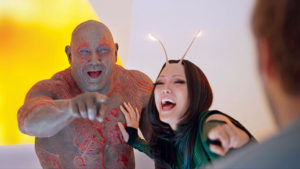
James Gunn paid a lot of extra attention to her design. The team at Legacy Effects went through many iterations for the design of Mantis before they landed on the final. Part of the design was going to be digital VFX antennae, and the director wanted the freedom to decide movements and final look later. The prosthetic that was created for Mantis included the base of the antennae, so that VFX would have a jumping-off point for placement.
Even after the 2D design phase was completed, we must have sculpted half a dozen versions of the forehead prosthetic for Mantis, trying to get the right shape, angle and size.
Once Pom Klementieff was cast for the role, we scheduled her for make-up testing. We wanted to keep her overall look very clean and classy. We knew that the focus was to be on her eyes. So, aside from wearing 22mm contact lenses, painted by Cristina, the make-up design would need to make her eyes look as big as possible … alien. I chose Mike Ornelaz to be the lead make-up artist on Mantis. Together, we worked out colors, direction and scheme that would transform Pom. When the schedule allowed, Scott Stoddard helped Mike get through the prosthetic portion of the make-up application, but then stepped back while Mike finished the beauty aspect of the make-up.
To help with the alien illusion of the large eyes, Shane had an idea for these long sweeping wispy lashes. Ornelaz created the custom lashes from ostrich feathers. Each pair was handmade and meticulously matched. They made about 65 pairs.
Mike Ornelaz and his hair team, including Aimee Macabeo, worked on Mantis’ wig. Using 2D designs, the hair department bought several wigs that were cut and styled, narrowing down the look that the director couldn’t quite place his finger on. Once the final design for the wig was chosen, Tina Fabulic was responsible for the hair wrap and application of the wig. Overall make-up application time, including hair wrap and wig for Mantis was 2 ½ to three hours.
Taserface
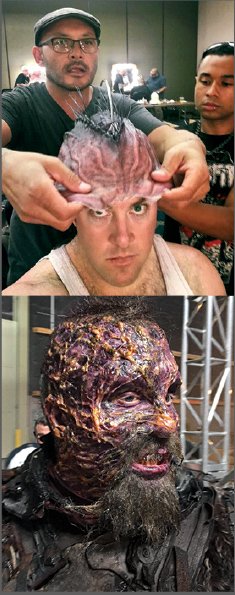
prosthetic to Taserface; after the burn.
Another new character for us to build was TaserFace, the leader of the Ravager uprising. Marvel took a while to come up with the initial design, one that would fit in the world already created, but still be different than the other Ravagers. Legacy translated the initial design over Chris Sullivan’s features. John Cherevka created the dental prosthetics and Chris Swift did the sculpt of the full-face prosthetics. Laura Dandridge was my make-up application partner.
Taserface’s prosthetic make-up broke down into a top-of-the-head piece that came down and covered his brows, a face piece, a chin, ear pieces and the Horsetail Mohawk. He also had lace mustache and beard pieces. To save time, we decided to omit the chin, as it was covered with the big bushy facial hair. One of Taserface’s prominent features is the “Horsetail Mohawk.” Mike Ornelaz fabricated the giant hairpiece at L.E. The overall length was almost three feet long, and was heavy, dense hair. Mike had to attach the wig to the actor so that it would hold the weight but not lose the integrity of the design. The actor agreed to shave his head. We made a thin fiberglass shell that we could mount to. Mike and the mechanical department at L.E. came up with an adjustable pivot rod that was mounted to the fiberglass shell. The “Mohawk” had a piece of vinyl tubing at the heart of the wig so that it could be slid over the pivoting rod. We used Skin-Tite, a two-part silicone, to adhere the fiberglass shell to the top of Sullivan’s head.
James Gunn wanted to make sure that the color scheme for Taserface was fun and bright. The prosthetics had been pre-painted from the shop, but as we did make-up tests in Atlanta, the scheme changed. We went through three different make-up tests to find the right tone of purple-ish.
For Taserface’s fiery demise, we didn’t have time to create a full burn make-up. Gunn wanted something that got the point across that he was burned, but nothing so gross or realistic that people would turn away. Laura and I fabricated a burn make-up out of the kit as a test to show the director. We kept the colors bright underneath to be his flesh color, yellow to be exact. The test was approved, and repeated on the day of the shoot. We had doubles of the facial hairpieces and the “Mohawk,” that could be burned, singed and charred. Overall application for the Taserface make-up was two to 2 ½ hours. Cristina worked with Shane Mahan and Lindsay MacGowan on the look and design of the Taserface contact lenses.
Ravagers

The Ravagers in this universe come in all shapes, sizes and volume. The make-up work for the Ravagers was divided between the L.E. make-up department focusing on the larger prosthetic make-up designs, and smaller prosthetic or other make-up designs created by John Blake and his make-up department.
Marvel provided the molds from the first movie to recreate some of those original Ravagers, and Legacy got to create some new Ravagers. The in-house design team and painters came up with new paint schemes for the original characters so we could create as many looks as possible. The Ravager make-ups ran the gamut of pre-painted silicone prosthetics, foam latex and fiberglass headpieces.
The main body of the Ravager shots in the film were shot during the first five weeks of principal photography. I was able to assemble a large team of fantastic make-up artists from 706, including Alexei Dmitriew (key make-up), Scott Stoddard (key make-up), Mike Ornelaz (key make-up), Chris Nelson, Tina Fabulic, Mike Mekash, Will Huff, Vera Steimberg, Kevin Kirkpatrick, James MacKinnon, Bart Mixon, Sabrina Wilson, Cary Ayers, Dave Snyder and Nicole Sortillon-Amos.
Local 798 members included Matt Sprunger, LuAndra Whitehurst, Laura Dandridge, Mark Ross, Jonah Levy, Addison Foreman, Matt Silva, Emily Coughlin, Kerrin Jackson and Jessica Gambardella. And from the UK, working under 798 were Robin Pritchard and Jon Moore.
Credit Where Credit Is Due
Besides the large Legacy Effects group on set, the team is not complete without the members back at the shop in San Fernando responsible for the build. I can’t name everyone here but I just wanted to give credit to the department leads for this massive undertaking: Damien Fischer, who runs the mold shop, along with Jeff Dietz as his key. Cory Czekaj as the silicone and foam latex fabrication room lead. Jamie Grove, Ryan Pintar, Mark Maitre, Bruce Fuller, Tim Martin, John Cherevka and Shane Mahan as key painters. Nicki Harris, who wrangled most of the contact lens work on set, with help from Sean Kinney, Justin Faith and Jessica Nelson.
One member of this team I had HUGE help from was Kelly Zak, who helped me organize and coordinate to keep this train on the rails. Thank you ALL.
Wrapping This Up (Finally)
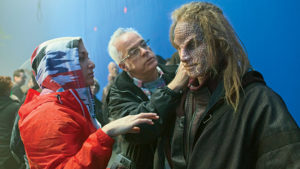
During the first week of make-up tests at Pinewood Studios in Atlanta, there was a day that we had about 20 of our Ravagers all made up and in front of the camera. The director and production gave us all thumbs up. I remember that moment, looking at this motley crew of silicone prosthetics and paint. There was a lot of buildup to this make-up test. From all the work done at Legacy Effects, from the design team, sculptors, moldmakers, prosthetic fabricators, painters and the hair department to finally, the make-up artists and hair stylists on set. Many hands touched these characters. But when it’s all said and done, and the work is successfully living and breathing in front of the camera, those are the moments why many of us got into the business.
Big shoes to fill, yes. But as a team, we laced up and ran. •
